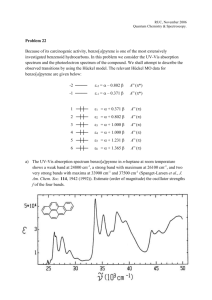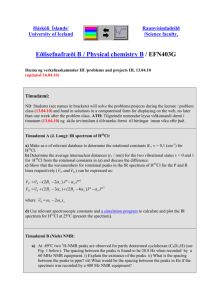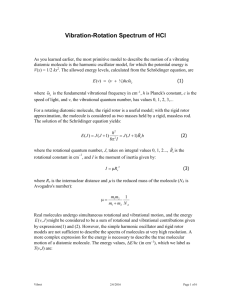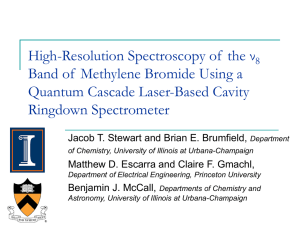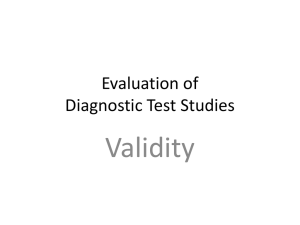Rotationally-resolved infrared spectroscopy of the polycyclic
advertisement
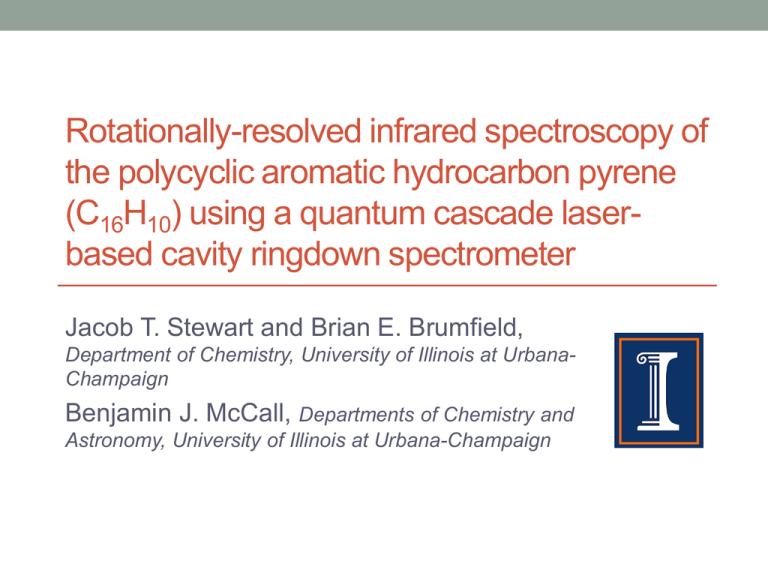
Rotationally-resolved infrared spectroscopy of the polycyclic aromatic hydrocarbon pyrene (C16H10) using a quantum cascade laserbased cavity ringdown spectrometer Jacob T. Stewart and Brian E. Brumfield, Department of Chemistry, University of Illinois at UrbanaChampaign Benjamin J. McCall, Departments of Chemistry and Astronomy, University of Illinois at Urbana-Champaign Our goal at 8.5 µm • Our goal is to observe the 8.5 µm vibrational band of C60 to aid in astronomical studies • We have built a sensitive mid-IR spectrometer and measured the 8 mode of methylene bromide • We have attempted to observe C60, but have not seen any signal yet B. E. Brumfield, J. T. Stewart, B.J. McCall, J. Mol. Spec., 266, 57 (2011). Seeking an intermediate challenge Walk in the park Trip to the moon Pyrene C16H10 Coronene C24H12 Ovalene C32H14 400 K C60 1000 K Toven increasing with mass to produce necessary number density 26 atoms 60 atoms Increasing Qvib • • Only pyrene has an IR active mode within QCL frequency coverage Largest molecule to be rotationally resolved using infrared direct absorption spectroscopy Previous work on this band • 1184 cm-1 band previously measured by Joblin et al. • Band strength has been measured experimentally • Allows us to estimate degree of vibrational cooling Ne matrix (4 K) CsI pellet (300 K) Gas phase (570 K) Joblin et al., Astron. Astrophys., 299, 835 (1995). Getting sample into the gas phase • Designed an oven to hold•>50 g ofansample Need oven that can • Horizontal orientation allows liquid sample operate up to 700°C • Can operate up to at least 700°C for hours for many hours • Needs to be able to hold large amount of sample • Must be able to hold liquid Our mid-IR spectrometer •Fabry-Perot quantum cascade •Rhomb and polarizer act as an lasers provided by Claire Gmachl at optical isolator Princeton •Total internal causes a •Housed in areflection liquid nitrogen cryostat phase shift in the light •Lasers can scan from ~1180-1200 cm-1 (not necessarily continuous) B. E. Brumfield et al., Rev. Sci. Instrum., 81, 063102 (2010). The pyrene vibrational mode • This mode is a C-H bending mode • Pyrene is an asymmetric top (D2h point group) • This is a b-type band (ΔJ = 0,±1; ΔKa=±1; ΔKc=±1) Overall spectrum • PQQR structure of a b-type band with little intensity near the band center • Strong P and R-branches indicate a small change in rotational constants in the vibrationally excited state Changing rotational constants in the excited state Simulation from our assignment of the spectrum Each tall peak we observe is actually a stack of many transitions Simulation with B’ decreased by 0.1% relative to B’’ Simulating the spectrum • We used PGOPHER to fit and simulate the spectrum • Ground state rotational constants published by Baba et al. • Values obtained from fluorescence excitation spectroscopy Baba et al., J. Chem. Phys., 131, 224318 (2009). PGOPHER, a Program for Simulating Rotational Structure, C. M. Western, University of Bristol, http://pgopher.chm.bris.ac.uk Discrepancy with fluorescence excitation spectrum • Cannot fit spectrum using Baba et al.’s constants • If we allow ground and excited state constants to float during the fitting we obtain a good fit (standard deviation of 0.00036 cm-1 (11 MHz)) • Ground state constants from fit are statistically different from Baba et al. • This discrepancy between ground state constants is still being Our investigated – Baba combination differences using our fit (cm-1) et al. Difference % difference data confirm 300 ourMHz ground state assignment-4 A’’ 0.0337202(12) 0.0339147(45) -1.95×10 0.6% B’’ 0.0185559(12) 0.0186550(32) -9.91×10-5 C’’ 0.01197271(61) 0.0120406(24) -6.79×10-5 0.5% Trot = 20 K linewidth = 10 MHz 0.6% Vibrationally excited state v=0 (cm-1) 0 v=1 Difference % Difference 1184.035561(32) A 0.0337202(12) 0.0337138(13) 6.4×10-6 0.019% B 0.0185559(12) 0.0185554(12) 5.0×10-7 0.002% C 0.01197271(61) 0.01197111(64) 1.8×10-6 0.013% • Rotational constants change very little in the vibrationally excited state • B is statistically unchanged between ground and excited states • Centrifugal distortion constants were unnecessary to fit the band Estimating the vibrational temperature • Using our assignment, we can calculate the expected spectrum at a vibrational temperature of 0 K • Compare expected spectrum to experimental spectrum to estimate Tvib Observed absorption = Calculated absorption 𝑄𝑣𝑖𝑏 × 𝐶𝑐𝑙𝑢𝑠𝑡𝑒𝑟 • Estimate column density from: • rate of mass loss from the oven (25 g in ~20 hr) • gas velocity in the expansion • vertical distribution in the expansion • overlap of TEM00 mode of cavity with expansion Estimating the vibrational temperature • Band strength for pyrene mode is known (10 km/mol) • Using this information we can calculate Qvib × Ccluster to be ~1.3 • Doubling backing pressure did not lead to decrease in absorption – assume Ccluster = 1 (no clustering) • Use scaled harmonic frequencies to calculate Qvib as a function of temperature Tvib = 60 – 90 K S. R. Langhoff, J. Phys. Chem., 100, 2819 (1996). Conclusions • We have measured and assigned rotationally- resolved infrared spectrum of pyrene • Largest molecule observed with rotational resolution using infrared absorption • Large molecules can be cooled effectively by supersonic expansion Future Work • Try to resolve discrepancy between our work and fluorescence excitation spectroscopy • Continue to try and observe C60 spectrum • Develop an external-cavity QCL system to extend frequency coverage • Continue on to larger PAHs, such as coronene Acknowledgments • McCall Group • Claire Gmachl • Richard Saykally • Kevin Lehmann
